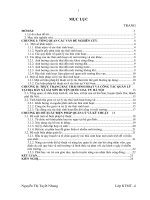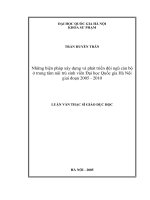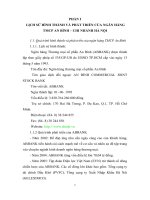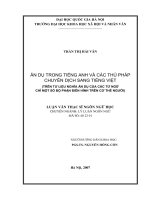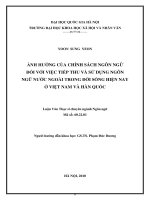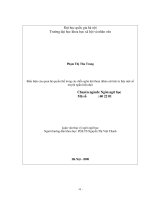- Trang chủ >>
- Cao đẳng - Đại học >>
- Luật
(Luận văn thạc sĩ) chuyển biến kinh tế xã hội xã sài sơn, huyện quốc oai, hà nội giai đoạn 1986 2010 luận văn ths khu vực học 60 22 01 13
Bạn đang xem bản rút gọn của tài liệu. Xem và tải ngay bản đầy đủ của tài liệu tại đây (4.15 MB, 145 trang )
VIETNAM NATIONAL UNIVERSITY, HANOI
INSTITUTE OF VIETNAMESE STUDIES AND DEVELOPMENT SCIENCES
VU THU HUYEN
SOCIO-ECONOMIC TRANSFORMATION OF SAI
SON COMMUNE, QUOC OAI DISTRICT, HA NOI
CITY IN PERIOD FROM 1986 TO 2010
MASTER THESIS
MAJOR: VIETNAMESE STUDIES
HANOI, 2014
VIETNAM NATIONAL UNIVERSITY, HANOI
INSTITUTE OF VIETNAMESE STUDIES AND DEVELOPMENT SCIENCES
VU THU HUYEN
SOCIO-ECONOMIC TRANSFORMATION OF SAI
SON COMMUNE, QUOC OAI DISTRICT, HA NOI
CITY IN PERIOD FROM 1986 TO 2010
Master thesis, major: Vietnamese studies
Code: 60 22 01 13
Supervisor: Prof.Dr. Truong Quang Hai
Hanoi, 2014
ACKNOWLEDGEMENTS
This thesis is the result of training process in Institute of Vietnamese
studies & Science of Development as well as my process of surveying and
researching last time.
First of all, my profound thanks are due to Prof. Dr. Truong Quang Hai who
guided me and spent valuable time to explain and make orientation for my research.
The thesis is successful thanks to his important help.
Secondly, I would like to give my sincere thanks to the teachers presenting
lectures at the sixth class of master’s degree as well to the teachers in Management
Board of the Institute and Training Department providing me the best conditions in
studying progress to complete this thesis.
Finally, I would like to give my thanks to my family, friends encouraging me
to study and research.
Sincerely!
Ha Noi, August 12, 2014
Student
Vu Thu Huyen
DECLARATION
I certify that no part of this thesis is copied or reproduced by me from any
other someone’s work without acknowledgement and that the thesis is originally
written by me under strict guidance of my supervisor Prof.Dr. Truong Quang Hai.
Student
Vu Thu Huyen
CONTENTS
INTRODUCTION ...................................................................................... 1
1. Rationale of the thesis.................................................................................... 1
2. Listerature review ......................................................................................... 2
3. Objectives, research scope and research tasks ............................................. 4
4. Material resources and research methods.................................................... 7
5. Contribution of the thesis .............................................................................. 8
6. The structure of the thesis ............................................................................. 9
Chapter
1
THEORETICAL
BASIS
OF
RESEARCHING
SOCIO-
ECONOMIC TRANSFORMATION IN THE PERIOD OF DOI MOI AND
INTRODUCTION TO SAI SON COMMUNE ...........................................10
1.1. Theoretical basis of researching socio-economic transformation in the
period of “Doi Moi”......................................................................................... 10
1.1.1. Basic concepts .................................................................................... 10
1.1.2. Factors affecting the socio-economic rural Sai Son in Doi Moi era .. 15
1.2. Overview of Sai Son commune................................................................. 17
1.2.1. Natural conditions of Sai Son commune ............................................ 17
1.2.2. History and people of Sai Son ............................................................ 22
1.2.3. Overview of socioeconomic situation of Sai Son commune before 1986 .... 25
Sub-conclusion ................................................................................................. 30
Chapter 2 BASIC ECONOMIC TRANSFORMATIONS OF SAI SON
COMMUNE FROM 1986 TO 2010 ...........................................................31
2.1. Basic economic transformations of Sai Son commune from 1986 to
1996 .................................................................................................................. 31
2.1.1. Transformation in the operation of agricultural cooperatives and land
using rights................................................................................................... 31
2.1.2. Economic restructuring in the period 1986-1996 of Sai Son
commune ..................................................................................................... 34
2.2. Economic transformation of Sai Son commune in the period 19962010 .................................................................................................................. 39
2.2.1. The important changes of the units of administrative boundaries and
preferential policies of investment situation ................................................. 39
2.2.2. Conversion of land use purpose ......................................................... 41
2.2.3. Economic restructuring in the period 1996-2010 ............................... 42
2.2.4. Internal transformation of agriculture ............................................... 44
2.2.5. Transformations of Industry-Handicraft of Sai Son commune in the
phase 1996-2010 ........................................................................................... 53
2.2.6. Transformations of Commerce - Services - Tourism .......................... 57
2.2.7. The situation of receiving projects ...................................................... 60
2.2.8. The situation of constructing new rural ............................................. 62
2.2.9. The achievements of the basic construction ....................................... 64
Sub-conclusion of chapter 2 ............................................................................. 67
Chapter 3 BASIC SOCIAL TRANSFORMATIONS OF SAI SON
COMMUNE FROM 1986 TO 2010 ...........................................................69
3.1. Restructuring of labor and employment of Sai Son commune ............... 69
3.1.1. Restructuring of labor by sector ......................................................... 69
3.1.2. Labor structure by level ...................................................................... 72
3.1.3. Changes of labor psychology .............................................................. 74
3.1.4. Job creation ........................................................................................ 75
3.2. Completion level of education-training and medical of the commune ... 76
3.2.1. Education and training....................................................................... 76
3.2.2. Medical service ................................................................................... 79
3.3. Transformations of material life .............................................................. 82
3.3.1. Income - living standard ..................................................................... 82
3.3.2 Poverty situation and the gap between rich and poor .......................... 86
3.4. Transformations of cultural and spiritual life......................................... 89
3.4.1. Changes of the way of using spare time ............................................. 89
3.4.2. Changes in neighbor relations............................................................ 92
3.5. Negative changing of environment .......................................................... 93
3.6. The situation of security and order, social security ................................ 95
Sub-conclusion chapter 3 ................................................................................. 96
CONCLUSIONS AND RECOMMENDATIONS .......................................97
CONCLUSIONS ............................................................................................. 97
RECOMMENDATIONS .............................................................................. 100
REFERENCES........................................................................................ 105
SCHEDULE ............................................................................................ 113
LIST OF TABLES
Table 2.1: The structure of the economy in the period 1986-1996.......................... 34
Table 2.2. The situation of cultivation of Sai Son commune in the phase
1986-1996 ............................................................................................................ 35
Table 2.3: Fluctuations in land area according to the purpose of use in the period
2000-2010 ............................................................................................................. 41
Table 2.4: The income value of economic sectors of Sai Son commune in the period
1996-2008 ............................................................................................................. 43
Table 2.5: Value of agricultural production of Sai Son commune in the period
1996-2012 ............................................................................................................. 45
Table 2.6: The situation of rice production of Sai Son commune in the phase 19962012 ...................................................................................................................... 46
Table 2.7: The production situation of other food crops of Sai Son commune in the
period 1996-2012 .................................................................................................. 47
Table 2.8: Average food production per capita in the period 1996-2012 ................ 48
Table 2.9: Production situation of other annual crops in Sai Son commune in the
period 1996-2012 .................................................................................................. 49
Table 2.10: The number of pigs, cows, buffaloes and domestic fowls over theperiod
1996-2012 ............................................................................................................. 50
Table 2.11: Assessing difficulties in agricultural production in Sai Son commune
from 2008 to present.............................................................................................. 53
Table 2.12. The situation of handicraft production of Sai Son commune in the phase
1996-2012 ............................................................................................................. 54
Table 2.13: Income value from industry and handicraft production of Sai Son
commune compared with other communes of Quoc Oai district in 2000-2010 ...... 56
Table 2.14: Quantity of households and labors operating in the field of Commerce Services-Tourism of Sai Son commune in period 1996-2012................................. 58
Table 2.15: The situation of the basic construction in Sai Son commune in
1996-2010 ............................................................................................................. 65
Table 3.1. Household economy by sectors of Sai Son commune in the phase
1996-2012 ............................................................................................................. 70
Table 3.2. Income structure of households in Sai Son commune ............................ 72
Table 3.3. School students of Sai Son commune through years.............................. 77
Table 3.4. The medical facilities of Sai Son commune ........................................... 80
Table 3.5. The assessment of approaching level to public medical services of the
interviewees .......................................................................................................... 81
Table 3.6. Sai Son commune’s per capita income in the period 1986-2010 ........... 82
Table 3.7. Types of housing in Sai Son commune ................................................. 83
Table 3.8. The use of furniture in families of Sai Son commune through the years ...........85
Table 3.9.
Rural poverty standards and rate of poor households in Sai Son
commune through the years ................................................................................... 86
Table 3.10. Entertaining ways of Sai Son inhabitants in spare time ....................... 90
Table 3.11. Comments on the significance of local traditional festival ................... 93
Table 3.12. Assessment on Sai Son commune’s current environmental pollution .......... 93
Table 3.13. Landfill sites of Sai Son commune ...................................................... 95
Table 3.14. The situation of resolving social security cases in Sai Son commune............ 95
LIST OF FINGURES
Figure 2.1: The structure of the economy in the period 1986-1996 ........................ 34
Figure 2.2. Fluctuations in land area according to using propose ........................... 42
in the period 2000-2010 ......................................................................................... 42
Figure 2.3: Economic restructuring of Sai Son commune in the period 1996-2012 ......... 43
Figure 2.4: Value structure of agricultural production of Sai Son commune in the
period 1996-2012 .................................................................................................. 45
Figure 3.1. Population situation of Sai Son commune through years ...................... 69
Figure 3.2. Labor structure by level of Sai Son commune in stage ......................... 73
1998-2010 ............................................................................................................. 73
Figure 3.3. The types of housing in Sai Son commune .......................................... 83
Figure 3.4. The types of toilet in Sai Son commune through the stages .................. 84
Figure 3.5. The use of furniture in families of Sai Son commune through the
years ..................................................................................................................... 85
Figure 3.6. Entertaining ways of Sai Son inhabitants in spare time ........................ 91
INTRODUCTION
1. Rationale of the thesis
Comprehensive socioeconomic process of Doi Moi in our country has gone
through journey of more than twenty years (1986-2010) and transformed socioeconomic aspects of Vietnam towards industrial moderniration. Doi Moi has created
two trends of industrialization - modernization and urbanization at a rapid speed.
The areas impacted the most by two trends are suburban areas, particularly suburb
areas. Thus, the appearance of agriculture, rural areas and farmers of Vietnamese
suburban areas also changes notably. In addition to the opportunities and
advantages that those trends brought these areas face many challenges and
difficulties.
Sai Son commune of Quoc Oai district is a suburban agricultural commune
in Hanoi. From 1986 to now it is mostly affected by policies of Doi Moi process
and urbanization trend; especially in recent decade, increasing suburban factor has
enhanced its manitudes. The dynamic of inhabitants catching up with changes
inpolicies creates positive movement in Sai Son rural. Local authorities and
households here, by learning from experiences, gain achievements in the economic
restructuring in general and agricultural restructuring in particular, (developing
towards the production of goods ). In the district, industrial parks and urban
neighborhoods have been invested. There are structural changes in cultivation,
livestock breeding, agro-processing, in direction of gradually building a modern
urban area. This process not only changes the structure of physical space, but it also
changes the living conditions, living labor, advancement opportunities and the
lifestyle, the psychology of the people living here. Here there are some new and
modern elements of urban culture, the dissemination of cultural products, of literary
or artistic value, importing of lifestyle, communication style, and civilized
behavior..., known as new cutural nuance of the village. It can be said that the
appearance of agriculture, rural area and farmers is more modern and civilized
despite of inevitably negative elements existing or arising.
1
Studying socio-economic transformations in the suburban areas since Doi
Moi has been of interest by many authors but the focus is only on the first 10 years
of Doi Moi and limited within the study area of a district. There has been no prior
mention on Sai Son commune in the period from 1986 to present, during which
socio-economic situation of suburban areas as Sai Son was significantly under of
nationwide modernization and urbanization. There were some studies on this
problem, however the strongest transformations including positive and negative
impacts of the above factors were not yet mentioned. Moreover, they are often
studies of the specialized sciences such as history, economics, geography ... with
incomprehensive results. Therefore, based on the interdisciplinary approach in area
studies, the study on“Socio-economic transformation of Sai Son commune, Quoc
Oai district, Ha Noi city in period from 1986 to 2010” has scientific as well as
practical significance and urgent nature.
2. Listerature review
The contents of the study are economic transformations of a suburban
countryside, which is an agricultural village so the transformations are also
associated with agriculture, rural and farmers. Researching socio-economic
transformations in rural areas since the beginning of Doi Moi has to stem
necessarily from the situation of agriculture, rural and farmers in Vietnam before
Doi Moi process. There are many research works referring to the subjects and this
era of Vietnam such as : The real situation of agriculture, rural areas and farmers in
Vietnam (1976-1990) ( Nguyen Sinh Cuc , 1991 ) [9] ; Socioeconomic issues
through three surveys of agriculture, industry, housing ( Le Van Toan , 1991 ) [ 77];
Surveying forms of cooperative organization of farmers in our country today ( Dao
The Tuan , 1995) [80] …
Researching works on this issue provided an overview of the current state of
agriculture and socioeconomic rural in the time of Doi Moi with many limitations
such as the obviousness of psychology and traditional production practices; pure
agricultural structure, rice monoculture, intensive food production with selfsufficiency, and economic sectors in a long time only allowed to exist in two forms
2
of state-owned and collective; inefficient management model of concentration
and bureaucratic habits; poor market in general, especially the rural market;
common phenomenon of poor in rural; unemployment of rural workers; poor
infrastructure of the rural ... (Nguyen Dang Chat, 1994) [8]. At the same time,
they posed and solved many theoretical problems of the road for rural to go to
socialism, of the successes and failures of cooperation, collective agriculture and
rural areas throughout the country.
From that current situation, many authors focused on studying the
transformations in the society and economy in rural areas of Hanoi and some other
localities in the country since the Doi Moi, such as: the economy and society of
rural in Gia Lam district - Ha Noi on Doi Moi process (Tran Thi Tuong Van, 2004)
[89]; Transformation of villages in Vietnam Red River Delta nowadays (To Duy
Hop, 2000) [26]; Transformations of socioeconomic structure of a commune in the
Red River Delta, Phung Thuong commune (Ha Tay) from 1954 to now (Bui Hong
Van, 2002) [87]; Socioeconomic transformations of Phu Luong district, Thai
Nguyen province in Doi Moi era (1986-2005) (Tran Minh Thu, 2010) [68] …
The Doi Moi process in rural suburb areas of Hanoi has differences
compared to other rural areas because it is associated with the process of
urbanization. Some aspects of the urbanization process in the coastal area of Hanoi
in Doi Moi process are mentioned in many publications. Socioeconomic
transformations of suburban areas in Hanoi in urbanization process happen in all
sectors: occupational structure, income, standard of living, housing and
infrastructure; physical and spiritual life (Nguyen Huu Minh, 2005) [42, pg.56]. In
particular, the most significant transformation is in the career structure. Due to the
impact of urbanization, land area losing, farmers lost key production materials.
They take compensation but do not know to create opportunities to convert their
careers. Besides, the ineffective interest of authorities makes them struggle to find a
way to survive. This poses the problem of converting jobs before whirlwind of
urbanization. This problem has also been given many authors as the urgent social
problems needed to be studied and solved such as: Employment for farmers in the
3
Red River delta in the process of industrialization and modernization, (Bui Thi
Ngoc Lan, 2007) [33]; Solving the problems of labor and employment in the
agricultural and rural urbanization as well as industrialization process (Nguyen Huu
Dung, 2004) [12]... Some other urgent problems of migration and environment due
to urbanization such as: free migration during urbanization and its impact on the
environment of Hanoi city (Do Thi Thanh Hoa, 1999) [25], the main solutions to
overcome the effects of urbanization on environment of urban areas in Hanoi
(Nguyen Huu Sung, 1995) [59] ... A number of implications of urbanization in
suburban areas referred such as growing differentiation in a part of the population
[46, p.134]…
Overall, the recent research works with the research direction closing to the
one of the thesis provided the approaches, investigation, so the author can construct
the best research direction suitable to chosen local. It can be said, there is no work
to comprehensively study economy and society of Sai Son commune in the period
from 1986 to 2010. Therefore, based on area studies with deep investigation, a
systematic analysis of these issues of economic restructuring, occupational
structure, lifestyle changes ... and impact of these factors on the total socioeconomic transformations of Sai Son commune in Doi Moi affected by the trend of
modernization and urbanization becomes a subject having scientific practical and
urgent significance. It should be studied seriously, creating a scientific basis for
evaluating the current situation, learning lessons and orienting policies and
sustainable development for the local.
3. Objectives, research scope and research tasks
3.1. Objectives
Since the comprehensive implementation of the Party and State on
socioeconomic policies in Doi Moi (1986), Vietnamese rural in general and Sai Son
rural in particular have many positive signs. With the policies of agricultural
modernization and rural development of the Party and State, trend of urbanization
and the advantages of a suburban area, socio-economic situation of the Sai Son has
significant growth. There are many transformations of economic structure in the
4
direction of industrialization; the living quality of residents is enhanced. With
modernity, lifestyle of local community directs to the structure of an urban
community. Thus, the thesis aims to objectives being main socio-economic
transformations of Sai Son commune since Doi Moi. By dividing into small stages,
the research will clarify the main impacts of factors on the economy and society of
locality at each stage; also assess the positive factors inherited and negative factors
drawn to learn for the growth of next period. In those objectives, Sai Son resident
community is the subject making transformations. Thus, the thesis also aims to
explore the lifestyle of inhabitants in the past and present.
3.2. Research aims
The thesis aims to clearly realize the socio-economic situation and
transformations of Sai Son commune in the period 1986-2010; to assess those
transformations and to propose solutions for local sustainable development.
3.3. Research tasks
Clarifying the theoretical basis, the basic concepts related to issues
Learning, analyzing and evaluating economic transformations of Sai Son
commune through contents: The economic restructuring, the restructuring of the
agricultural sector; Status of conversion process of land uses; especially agricultural
land; The transformation of non-agricultural economic sectors and increasing
important role of them; The development and improvement of local infrastructure;
the situation of building new countryside.
Learning, analyzing and evaluating economic transformations of Sai Son
commune through contents: The transformation in the structure of labor employment; status of poverty and the gap of rich and poor; perfect level of local
education and training of medical; The transformation of material - cultural spiritual life
Based on the research results obtained, suggesting some recommendations
and solutions to improve policies of development and management of Sai Son
commune.
5
3.4. Research scope
The thesis researches socioeconomic transformations of Sai Son commune,
Quoc Oai district, Hanoi in the period 1986-2010.
About the time:
Thesis limits research time from 1986 to 2010. During that time, Sai Son
commune was influenced by a lot of larger transformations such as: beginning
comprehensive reformation and achieving many significant accomplishments,
accelerating the progress of industrialization and modernization when merging into
the administrative boundaries of Hanoi, officially becoming a part of the capital.
About Space:
Research site consists of 6 villages in the commune, they are: the village of
Phuc Duc, Thuy Khue, Da Phuc, Sai Khe, Khanh Tan and Nam Trai.
Scientific scale:
Due to the limitation of local storage socio-economic materials of Saison in
the first ten years of Doi Moi remains no more. The author had to use the method of
directly interviewing the officials in this period of time, old local people and the
method of comparing to other localities in the same district, province, and period to
generalize information about the socio-economic differences of Sai Son commune
compared to the period time before Doi Moi.
Sai Son commune covers an natural area of 1007.08 ha, with more than
4,000 households, divided into 6 villages as described above. During the field
survey, the author distributed 200 questionnaires to all rural households.
Interviewed households were randomly selected based on the following criteria:
road access, having sidelines, priority family...
In researching economic transformations, the researching time is divided into
two periods particularly the period of first ten-year of Doi Moi from 1986 to 1996
and the period from 1996 to 2010. This division is based on materials the author
gathered and way of summarizing and evaluating achievements of Doi Moi from
other studies.
6
In researching social transformations: Through the synthesis of investigation
results and the experience of being a local person, the author realizes the clear
changes in income, housing, toilets, the use of the furniture facilities, the use of
leisure time, neighborhood relations in Saison from the 2000s onwards. So, in a
content having field survey results, the transformations are reflected through the
time before and after the year 2000.
4. Material resources and research methods
4.1. Material resources
The thesis mainly exploits and uses the following resources:
1/ Bibliographies, reports, texts, tables, statistics... of the commune and
district.
2/ Documentation from field surveys
Using the field methods, sociological surveys by questionnaires, focusing
surveys on some key issues:
- Status of human labor, occupation of the members in farmer families in the
commune.
- Transformations in economic activities of farmers in the process of
urbanization due to selling their land or land acquisition by the State, land using
transition, or not using land for agricultural production.
- Changes of environmental sanitation conditions affecting daily life and
agricultural production.
- The transformation of environment, neighborhood relations of local people.
- Transformations in the physical, cultural and spiritual life of local people
due to direct impacts of process of urbanization.
3/ Research works related to the previous authors.
Of three above material resources, the first and second ones play important roles.
4.2. Research methods
Stemming from the object and proposed research tasks, the thesis applies
multidisciplinary and interdisciplinary approach. The knowledge of geography,
ecology, geology ... is used to assess the natural conditions. Knowledge of social
7
sciences such as history, ethnography, cultural studies, economics, sociology ... is
used for researching the original characteristics, population structure, economic
structure and policies from time to time ... Besides, the thesis also uses a number of
methods:
Methods of inheriting: based on the studies of economic, cultural and social
transformations of suburb areas in the urbanization process; a number of
information, documents of Sai Son commune , including information regarding the
rationale, economy, culture, society ... the author acquires, inherits previous
research results from them.
Methods of statistic, synthesis and analysis of materials: After collecting
research works related to research issues needed to be clarified, and information,
data, statistics related to economy as well as society of Sai Son commune, we use
statistical method to resources related to subject, analysis and process local
socioeconomic data in order to clarify the rules of transformation, characteristics of
transformation before proposing more practical solutions.
Method of sociological surveys: To gather field materials, the author uses the
method of field surveys in local, uses socioeconomic questionnaires, deeply
interviews managers and residents in surveyed area to understand the psychology as
well as personal opinion of the interviewees.
Historical method and logical method are used in research process. These
methods help to recognize, evaluate and interpret things, the phenomenon in the
depth of history.
5. Contribution of the thesis
1/ Through collecting and analyzing archives of the commune and district as
well as fieldwork materials, the thesis reconstructs a specific socioeconomic context
of Sai Son commune from early Doi Moi process up to now. Thereby we can see
major transformations of socioeconomic structure under the impact of innovation
policy and urbanization trends.
2/ Based on practical limitations, negative transformations, the thesis
proposes a number of recommendations making orientation for socioeconomic
8
development of the commune in the future. The thesis can be references for those
who want to learn about Sai Son commune in the Doi Moi period or for leaders of
the commune in development planning.
6. The structure of the thesis
Besides the introduction, conclusion, recommendations, references and
appendix, the main contents of the thesis are presented in three chapters:
Chapter 1. Theoretical basis of researching socio-economic transformation
in the period of Doi Moi and introduction to Sai Son commune
Chapter 2. Basic economic transformations of Sai Son commune from 1986 to 2010
Chapter 3. Basic social transformations of Sai Son commune from 1986 to 2010
9
Chapter 1
THEORETICAL BASIS OF RESEARCHING SOCIO-ECONOMIC
TRANSFORMATION IN THE PERIOD OF DOI MOI AND
INTRODUCTION TO SAI SON COMMUNE
1.1. Theoretical basis of researching socio-economic transformation in the
period of “Doi Moi”
1.1.1. Basic concepts
1.1.1.1. Doi Moi
According to Great Vietnamese dictionary, "Innovation concept is
understood changing or making something change better or more advanced than
before" [91, pg.658]. This shows that the connotation of this concept is pointing
human activities change old and backward things into newer and more advanced
ones. With this connotation, innovation has various types with different levels such
as innovation of economy, polity, culture, society, action, organization management
mechanisms, production methods ... In each country, depending on historical
moment, innovation process has different contents, methods and results but
identical target of "changing old something into new and more progressive one."
Innovation is indispensable and objective. All things, phenomena, individuals,
communities, nations wanting to survive and adapt to environment (including the
natural environment and social environment) must innovate. Innovation is a daily
activity, the instinct of every individual and community in life to adapt to the
environmental transformation. Thus, innovation is "the active progress partly being
of the rule of self-movement and self-development of the all things" [5, pg.16].
Doi Moi process of Vietnam was marked by the Sixth Party Congress (in
December of 1986) with proposing Doi Moi methods after the process of strict selfcriticism and learning from many advocates, policies with mistakes in renovating
socialist, socialism construction and socio-economic management before. Doi Moi
was essentially an extensive and profound reformation of all fields. Particularly, in
the first phase of Doi Moi, in the socioeconomic field, two important issues
emerged:
10
1. Transferring economic model from centrally bureaucratic planning based
on public property of production materials with two main forms of state and
collective owner into the good economy of multiple elements, operating based on
market mechanism with the management of the State.
2. Democratizing socioeconomic life, promoting human factors and directing
to the highest purpose being serving people in all activities. It was necessary to
gradually build a law-governed State of the people, by the people, for the people.
Congress emphasized the special position of agricultural production being at
the top front, so the first priority was investment and construction of infrastructure
as well as techniques. Congress also advocated innovation of management
mechanism of agricultural cooperatives and radical promotion of farmers’ active
role. Food is one of the three major economic programs that Congress set out in the
5 year plan from 1986 to 1990.
1.1.1.2. Doi Moi in agriculture and countryside
The sixth Congress emphasized special position of agricultural production,
considered it the leading front as well as the key task of whole our Party and people.
Doi Moi in agriculture and countryside associated with the following contents:
investment in building infrastructure and technology; promoting the application of
sciences and technology, innovating management mechanism of agricultural
cooperatives as well as management policies of land and credit …
The innovation process of agricultural and rural mechanisms as well as
policies started in 1988 when the Politburo issued Resolution on innovation of
agricultural management which was continuously added and completed next
periods. It can be mentioned to some typical agricultural and rural policies, from the
beginning of Doi Moi as follows:
a. Agricultural and rural policies, from the beginning of Doi Moi to the year 2000
The resolution No. 10-NQ/TW (dated 04.05.1988) about management
innovation of agricultural economy, with basic contents:
- Rearranging and reorganizing agricultural production in direction to
specialization combined with general businesses; in which cultivation is associated
11
with livestock, agriculture-forestry-fish breeding is associated with industry and
transport, particularly processing industry and handicraft in rural areas.
-
Properly
using
economic
components,
reorganizing,
innovating
management of cooperatives; continuing to complete mechanisms of paying for
households and household members based on final products... to ensure that each
household member earned less or more than 40% yield they gained; selling with
good price or delivering production materials to members of cooperatives.
- Encouraging the labor redistribution in direction to specialization, and
development of family economy.
- Implementing distribution principle based on labor competence and
contribution shares of members in model transformation of cooperatives;
Overcoming egalitarianism and subsidization in distribution; household member
receiving land only has to do duty of paying taxes to the State.
According to the basic content of Resolution 10, mechanisms of focusing
administrative, bureaucracy and subsidization were broken. Relationships:
property (of production materials), management (of labor) and distribution (of
products) were adjusted to appropriate to the nature and degree of the productive
forces. [89, pg.77]
Then, Resolution 6 (dated 03/29/1989) added a number of issues related to
innovation of agricultural mechanism. State implemented policy of only price, food
circulation with freedom, expanding export market and tax stability. Farmer
households are recognized as self-controlled economic units, the basic units of
production in the countryside. [89, pg.79]
Mechanism of fixing labor productivity for each hosuehold took advantage
of abundant labor source of traditional farming families. That family economy was
appropriated made production have great adaptability: manual force production,
animal traction and modern production forces can be used in some areas, a number
of farming stages such as using machinery, chemicals and irrigation in agricultural
production. The collaboration among families within small scale helps to adapt to
the unusual properties of the weather and fully utilized labor (from young to old).
12
Because of being the owners of the land and all production materials household
members appreciated cultivating land more.
Resolution No. 05 on continuing to innovate and develop rural economy society (dated 06/10/1993), defined goals, viewpoints, orientations as well as also
set out specific duties and solutions of agricultural and rural development until the
year 2000 through the issuance of decrees and regulations on agricultural extension,
borrowing capital for rural economic development, modified land law,... System of
guideline, policies (particularly the Land Law (1993), the State has given farmer
households 5fundamental rights of land use: conversing, transferring, hiring,
inheriting, mortgaging, which created a more favorable legal framework and
macroeconomic environment to have a positive impact on the development of
agricultural economy and rural areas. In particular, the national agricultural
restructuring was innovated in the direction of specialization in the production of
agricultural commodities, making economic activities in rural areas be familiar
with, then adapt to market mechanism. [89, pg.83]
b. Notable agricultural and rural policies after 2000
Resolution No. 09/2000 "On a number of guidelines and policies on
economic restructuring and consumption of agricultural products" made orientation
for development of important manufacturing good sectors of agriculture in our
country. They were policies of maintaining the strength of food production,
developing food crops, short-term and long-term industrial crops with high
economic efficiency, developing livestock, poultry towards improving the quality.
At the same time, delivering certification of agricultural land use rights for farmers
was completed, unused land was inventoried, and ensuring the next 10 years all
capable land of agricultural production was put into effective use.
To support the implementation of those development goals in agriculture,
Resolution 09/2000 was issued with some financial innovation policies of tax,
investment, credit...
Resolution 09/2000 with rural economic goals and detail financial policies
contributed to support farmers. The macro policies stepped to accelerate the process
of agricultural modernization in rural areas.
13
Decision No. 132/2000/QD-TTG "on a number of policies to encourage the
development of rural professions." The professions regulated included handicraft
manufacturing in rural, construction and transport sector with commune scale and
other services for production and daily life of rural population. This decision was
applied to households, individuals, groups, teams, cooperatives, private enterprises,
joint stock companies, limited liability companies, partnership, generally referred to
as the profession establishment of rural. The greatest guideline is to make
orientation for the development of profession establishment of rural based on
market mechanism, ensuring sustainable development, maintaining rural good
sanitation, realizing industrialization and modernization of agriculture and rural,
planning facilities of traditional professions associated with the development of
cultural tourism. They are accompanied by the regulations to support the profession
establishment of rural.
Resolution "of accelerating industrialization and modernization of
agriculture and rural in the period 2001-2010 " pointed that the overall and longterm target of industrialization and modernization of agriculture and rural in the
period 2001-2010 was to build a great agriculture with commodity production,
efficiency and sustainability, productivity, quality and high competitiveness on the
basis of the application of sciences, advanced technologies to meet domestic and
export demand; to make rural increasingly prosperous, democratic, civilized with
rational economic structure, suitable production relations and the socioeconomic
infrastructure developed more modernly.
The new points in the policies of the Resolution by Central Conference 5 IX were:
Regarding to land: The State created favorable conditions for farmers to fully
and legally implement rights of land use, encouraged farmers to implement land
conversion on a voluntary basis; farmer could use value of land use right to
contribute share to develop production, business,...
In terms of finance and credit: The state balanced funds to invest
development of agriculture, forestry, fishery, salt production and adjusted
investment structure in direction to serving economic restructuring of agriculture
14
and rural. The credit organizations operated in various forms in countryside with
agreed interest rate and an increase in lending level towards the producers and
economic organization in rural areas. People's credit funds in the commune were
encouraged to develop; status of lending with high interest in rural was limited to
the lowest level... Tax for use of agricultural land was exempted for farmers in land
limits until 2010. Tax policies were adjusted and added to encourage enterprises in
investment of developing the rural economy. [92]
In general, the decisions and great resolutions of the Party and State with many
policies of supporting investment, tax, market ... towards agriculture, rural areas were
going to implement in the Doi Moi era, stimulating and opening the way of the national
development of the commodity economy. From here, the farmers can take on the key
role, manually create the material and cultural values of Vietnamese rural.
1.1.1.3. Urbanization
Urbanization is a social phenomenon related to the transformation of
economy - society - culture - space – environment, deeply associated with scientific
and technical advances, which creates good conditions for promoting labor division,
career transformation and formation of a new career ... as well as changing the
cultural and social life, improving living standards, changing lifestyle and social
interaction forms ... [61, p.8]
The comprehensive process of urbanization leads to in the development of
economy, society and environment. With Sai Son commune, Because of not being
considered as the urban area, the most obvious impacts of urbanization trend are
only expressed by changes of economic structure, market expansion, social labor
structure, lifestyle, family and environment.
1.1.2. Factors affecting the socio-economic rural Sai Son in Doi Moi era
The factors mentioned below create effective impacts of process
modernization and urbanization being inevitable trends of the Doi Moi process.
1.1.2.1 . The factor of resources
Natural resources: being factor determining the own strength of local when
starting innovation. The first advantage of the natural resource was initially focused
15


